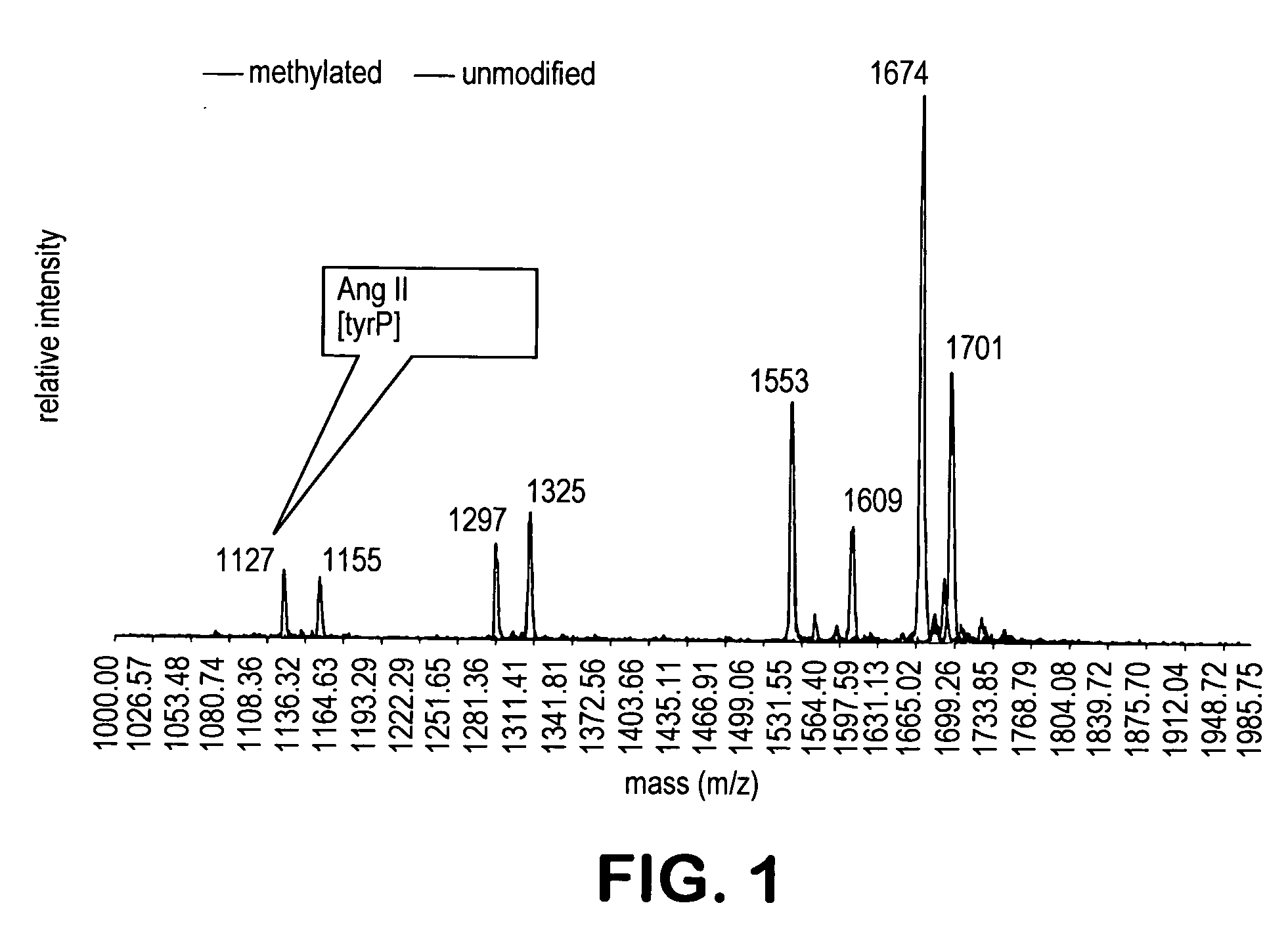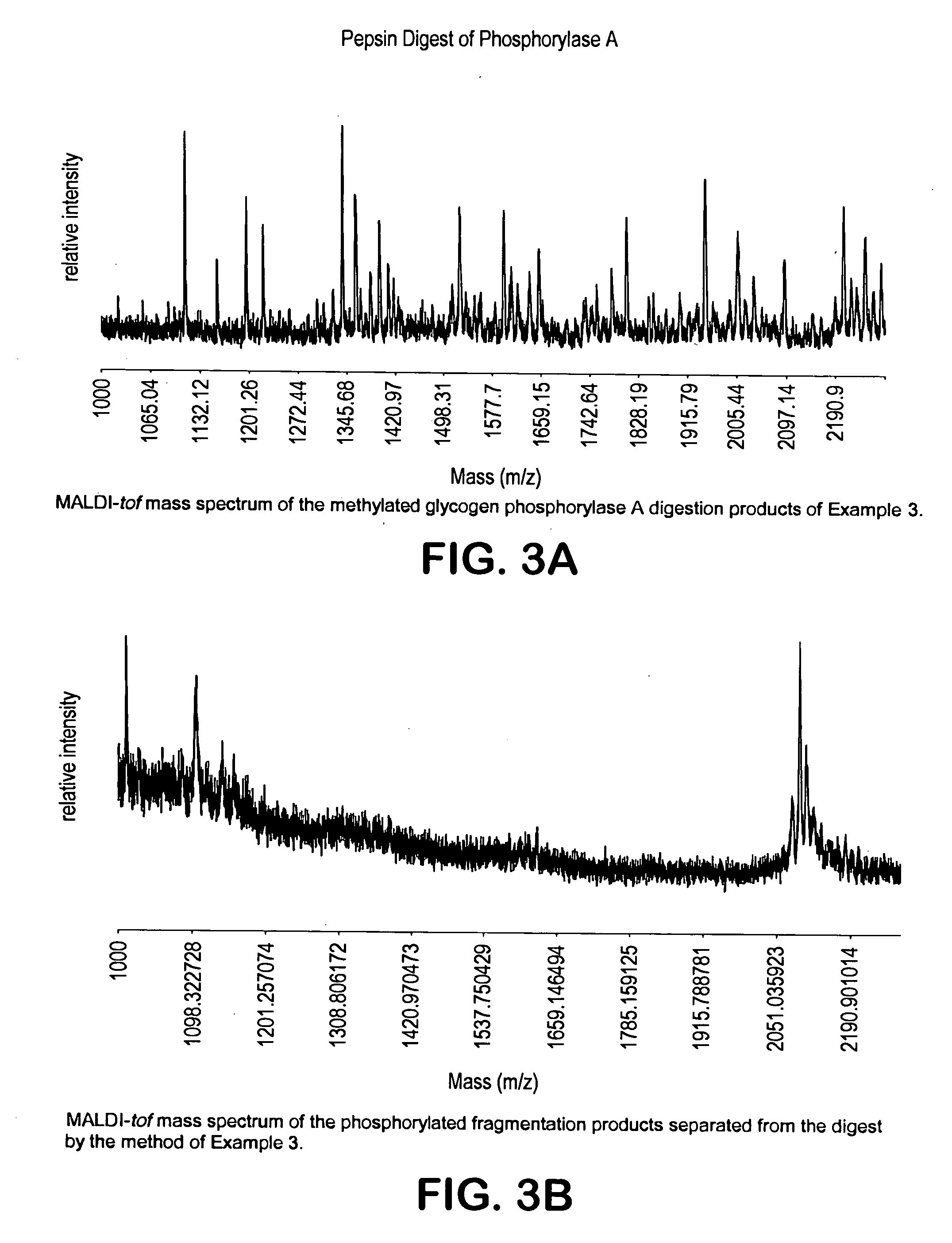Method for the enrichment and characterization of phosphorylated peptides or proteins
a technology of phosphorylated peptides and peptides, applied in the field of enrichment and characterization of phosphorylated proteins and peptides, can solve the problem that the method did not demonstrate usefulness for the comparative characterization of phosphorylated cell proteins and peptides
- Summary
- Abstract
- Description
- Claims
- Application Information
AI Technical Summary
Benefits of technology
Problems solved by technology
Method used
Image
Examples
example 2
[0211] This example illustrates the analysis of phosphorylated peptides from a peptide mixture by MALDI-tof mass spectroscopy.
[0212] The peptide mixture I of Example 1 was methylated for 30 minutes with anhydrous methanolic hydrochloric acid (2N) generated in situ from acetylchloride in methanol. An aliquot of mixture I was subjected to MALDI-tof. Comparison of the mass spectra of the mixture before and after the esterification indicates that this treatment quantitatively esterified all of the carboxylic acids, but none of the phosphate moieties present in mixture I (FIG. 1). Mass increases of 14 units per carboxylic acid corresponded to all of the carboxylic acids found in each of the peptide substrates.
[0213] Exposure of an excess of the a α-diazo-substituted resin (10 mg) to 500 fmol of the methylated mixture I in 500 microliter dimethylformamide overnight, resulted in the formation of a covalent phosphopeptide-resin bond. The unbound peptides were washed away with dimethylform...
example 3
[0217] The following example illustrates a method for the separation of phosphorylated peptides from a protein mixture and a method for the analysis of phosphorylated peptides from a peptide mixture by MALDI-tof mass spectroscopy and Edman degradation.
[0218] To evaluate the efficacy of the resin on a more complex peptide mixture the solid phase enrichment was performed on a chymotrysine digest of glycogen phosphorylase A (97 KDa).
[0219] The protein was digested with chymotrypsine (1:200 quantity of protein by weight) at pH 7.9-9.0 for 5 hours at room temperature to form peptide fragments. The peptides were dried completely. The fragmented protein products were then subjected to esterification by reaction with anhydrous methanol as described in Example 1. The MALDI-tof mass spectrum of the methylated crude product is shown in FIG. 3a. The crude methylated peptide mixture was subjected to the enrichment and the crude product isolated from the resin was analyzed by MALDI-tof (FIG. 3b...
example 4
[0220] Alternatively, small linkers can be introduced prior to resin binding. Unlike other methods, this approach is applicable to serine, threonine as well as tyrosine residues.
[0221] Methylation of the protein mixture under the conditions described in the earlier examples above protects the carboxylic acid moieties of the protein mixtures. Treatment of the protected protein mixture or digest with the α-diazo-thiol linker covalently links the phosphate to the linker which subsequently undergoes a conjugate addition with the pyrrole 2,5 dione substituted resin similar to the reported procedures (Scheme below).
[0222] The diazo group-substituted organic moiety in this approach is linked to a biotin derivative analogous to the biotin derivatives described by McLachlin, D. T.; Chait, B. T. “Analysis of phosphorylated proteins and peptides by mass spectrometry”, Current Opinion in Chemical Biology 2001, 5, 591-602).
[0223] The enriched sample of phosphorylated substrates from the prote...
PUM
| Property | Measurement | Unit |
|---|---|---|
| pore sizes | aaaaa | aaaaa |
| pore sizes | aaaaa | aaaaa |
| chemical composition | aaaaa | aaaaa |
Abstract
Description
Claims
Application Information
 Login to View More
Login to View More - R&D
- Intellectual Property
- Life Sciences
- Materials
- Tech Scout
- Unparalleled Data Quality
- Higher Quality Content
- 60% Fewer Hallucinations
Browse by: Latest US Patents, China's latest patents, Technical Efficacy Thesaurus, Application Domain, Technology Topic, Popular Technical Reports.
© 2025 PatSnap. All rights reserved.Legal|Privacy policy|Modern Slavery Act Transparency Statement|Sitemap|About US| Contact US: help@patsnap.com



